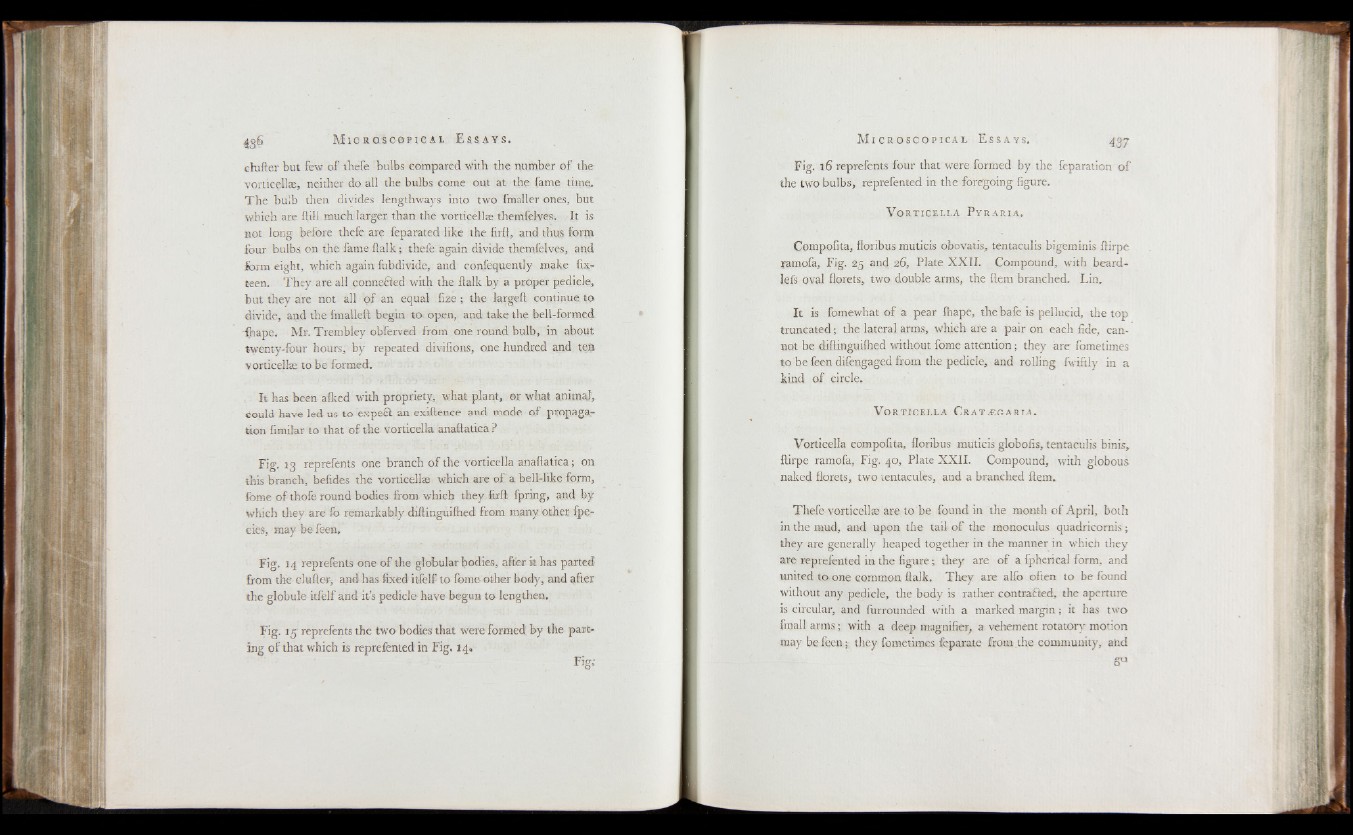
chifter but few of thefe bulbs compared with the number o f the
vorticelk, neither do all the bulbs come out at the fame time.
The bulb then divides lengthways into two fmaller ones, but
which are ftill much larger than the vorticellte themfelves. It is
not long before thefe are feparated like the firft, and thus form
four bulbs on the fame flails; thefe again divide themfelves, and
form eight, which again fubdivide, and confequently make fix-
teen. They are all connefted with the flalk by a proper pedicle,
but they are not all o f an equal fize ; the largeft continue to
divide, and the fmalleft begin to open, and take the bell-formed
fhape. Mr. Trembley obferved from one round bulb, in about
twenty-four hours, by repeated divifions, one hundred and tea
vorticelk to be formed.
It has been afked with propriety, what plant, or what animal,
could have led us to expeft an exiftence and mode of propagation
fimilar to that of the vorticelk anaftatica ?
Fig. 13 reprefents one branch o f the vorticella anaftatica; on
this branch, befides the vorticelk which are of a bell-like form,
fome of thofe round bodies from which they firft fpring, and by
which they are fo remarkably diftinguifhed from many other fpe-
cies, may be fees,
Fig. 14 reprefents one of the globular bodies, after it has parted
from the duller, and has fixed itfelf to fome other body, and after
the globule itfelf and it’s pedicle have begun to lengthen.
Fig. 15 reprefents the two bodies that were formed by the parting
of that which is reprefented in Fig. 14.
iF iperii
M i c r o s c o p i c a l E s s a y s . 437
Fig. 16 reprefents four that were formed by the reparation o f
the two bulbs, reprefented in the foregoing figure.
V o r t i c e l l a P y r a r i a .
Compofita, floribus mutieis obovatis, tentaculis bigeminis ftirpe
ramofa, Fig. 25 and 26, Plate XXII. Compound, with beard-
lefs oval florets, two double arms, the Item branched. Lin.
It is fomewhat o f a pear lhape, the bafe is pellucid, the top
truncated the lateral arms, which are a pair on each fide, cannot
be diftinguifhed without fome attention ; they are fometimes
to be feen difengaged from the pedicle, and rolling fwiftly in a
kind o f circle.
V o r t i c e l l a C r a t æ g a r i a .
Vorticella compofita, floribus mutieis globofis, tentaculis binis,
ftirpe ramofa, Fig. 40, Plate XXII. Compound, with globous
naked florets, two tentacules, and a branched Item.
Thefe vorticelk are to be found in the month of April, both
in the mud, and upon the tail o f the monoculus quadricornis ;
they are generally heaped together in the manner in which they
are reprefented in the figure ; they are of a fpherical form, and
united to one common ftalk. They are alfo often to be found
without any pedicle, the body is ratlier contracted, the aperture
is circular, and furrounded with a marked margin ; it has two
fmall arms ; with a deep magnifier, a vehement rotatory motion
may be feen; they fometimes feparate from, the community, and
S°